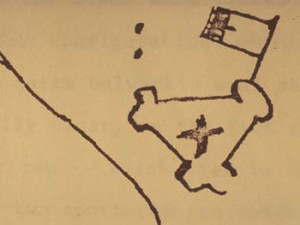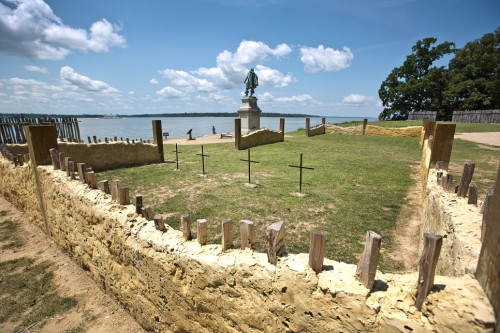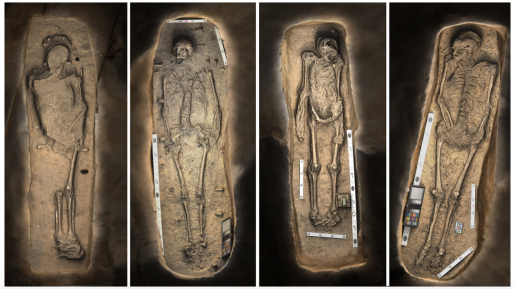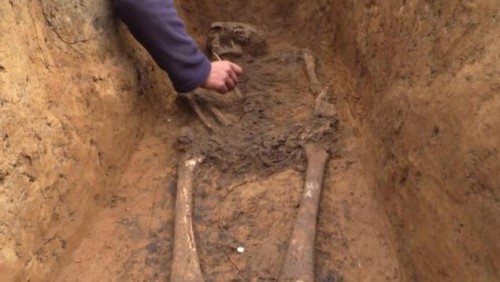Earlier this month, the family and I loaded up the car and drove south to Savannah, Georgia, making stops along the way at a number of significant historical sites. Among other places of interest, we visited Colonial Williamsburg, the site of the Wright Brothers’ first flight, and the “lost colony” of Roanoke. My favorite stop on the We’ll Make Our Kids Appreciate History If It Kills Us tour, however, was Jamestown… the site of the first permanent the English settlement in the Americas. [Jamestown, which was first settled in 1607, remained the capital of the Virginia colony for 83 years.] As we just had one day to spend exploring the area, we chose to forgo the “living history” of the Jamestown Settlement, which is a recreation of the town as it’s thought to have looked in the early 1600s, and spend our time instead with the archeologists of Jamestown Rediscovery, the non-profit that has been digging on the site of the original settlement since 1996.
Prior to the work of these archeologists, led by Dr. William Kelso, it was thought that the original settlement had been washed away, beneath a rising James River. Kelso and his team, however, proved conventional wisdom wrong. They found evidence of Fort James, and they’ve been working at the site ever since, slowly uncovering details about what happened on the site after May 1607, when 104 English men and boys arrived there from England with he intention of starting a settlement and extracting resources from the “new world” to send back home… Two-thirds of these men and boys, by the way, would be dead by the time supplies arrived in 1608, along with German, Polish and Slovak craftsmen to add to their numbers. [They apparently figured out pretty quickly that they needed settlers who actually knew how to do useful things.]
While walking around the site, the archeologists told us a little about their most recent discovery – the graves of four people who had been buried at the east end of what would have been the earliest known Protestant church in North America. The graves had been discovered in 2010, shortly after the discovery of the Anglican church’s foundation, but not excavated until 2013. As the graves would have been in a part of the church known as the chancel, where a community’s most important people were traditionally buried, the archeological team knew that these were the remains important early settlers, but that’s all they would say. They wouldn’t tell us who they thought it was that they’d exhumed. To learn that, they told us, as they led us around the crosses that marked their graves, we’d have to wait a few weeks, until they issued the report they’d coauthored with Dr. Douglas Owsley, the head of Physical Anthropology at the Smithsonian Museum of American History. Apparently all of the remains had been shipped off to DC for analysis, and the results would be announced on July 28… which is today.
Here are 3-D renderings of the four skeletons found buried near the altar of the Jamestown church, where, by the way, is were Pocahontas and John Rolfe were married. [Pocahontas died shortly thereafter, after being taken to England to advertise for the colony.]
By looking at the physical evidence (what the men were buried with, and how they were buried), along with historical documents in both the United States and England, and the findings of forensic scientists (who looked at things like lead content in the bones in order to determine social standing (the wealthier you were, the more lead in your system, as you tended to eat from plates and utensils with high lead content)), they’ve arrived at the following… The men buried near the alter of the church which stood inside the walls of Fort James, they believe, are…
The Rev. Robert Hunt: The first pastor to the colony, an Anglican priest, he arrived in 1607. Hunt soon lost all his possessions in a fire. The next year he died at about age 39.
Capt. William West: He was a gentleman, and a relative of the colony’s first governor. West died in 1610 at about age 24, fighting Indians. A silver sash was in his coffin.
Sir Ferdinando Wainman: A soldier, horseman (thus the strong thighs) and an English knight, Wainman was in charge of ordnance and horses. He died in 1610, and was about 34.
Capt. Gabriel Archer: His family, in fact, was Roman Catholic and, according to records found in England, had been persecuted for failing to attend Anglican church services. It was his grave where the reliquary and the staff were found. Archer was about 34 years old when he died in 1609.
Others who died in the colony, it should be noted, didn’t fare as well. Earlier research by Kelso and his team showed, for instance, that a 14-year-old servant girl, who the people of Jamestown Rediscovery call Jane, was butchered and consumed after dying during what’s known as “the starving time,” shortly after arriving at the settlement in August of 1609 on one of six ships from England bringing new settlers, but little food.
Kelso, according to National Geographic, didn’t believe historical accounts regarding cannibalism at Jamestown until finding Jane’s mutilated bones among those of butchered animals. Prior to this discovery, he thought that claims of cannibalism documented in England were politically motivated, and intended to discredit the Virginia Company of London, which financed the settlement. “Now,” Keslo told National Geographic, “I know the accounts are true.” Among other evidence conveyed by her remains, “numerous cuts, saw marks, and gouges along her lower jaw made by the tip of a knife to get to the meat, and to remove throat tissue and the tongue,” were found.
It’s gruesome stuff, but it was infinitely interesting to Clementine, who turned 11 on the trip… the idea that this young servant girl, who was about her age, had died and been eaten over 400 years ago, just feet from where we were standing. [If you’ve got a young person who you’d like to get interested in either archeology or this period of early American history, there’s a video called Jane: Starvation, Cannibalism, and Endurance at Jamestown that you can rent through Amazon.]
If you’d like to know more about this most recent Jamestown discovery, I’d suggest reading the article just posted to the website of the Smithsonian Magazine, which has a great deal of detail about not only these new findings, but about the history of the Jamestown settlement. Here, by way of that article, is a bit of that background.
…Jamestown was England’s attempt to play catch-up with the Spaniards, who had enriched themselves spectacularly with their colonies in South America and were spreading Catholicism through the world. After years of war with the Spanish, financed in part by pirating their ships, England turned to the Virginia Company to launch new colonial adventures. The first 104 settlers—all men and boys, women didn’t arrive until the next year—sailed with a charter from their king and a mission to find silver and gold and a passage to the Far East. They landed in Jamestown, prepared to scout and mine the land and trade with the native people for food. And they did trade, exchanging copper for corn between eruptions of hostility. But as Jamestown’s third winter approached, the Powhatan had limited supplies of corn; a drought was smothering their crops and diverting the once plentiful giant sturgeons that fed them. When English resupply ships were delayed, and the settlers’ attempts to seize corn turned violent, the Powhatan surrounded the fort and killed anyone who ventured out. Brackish drinking water, brutal cold and the lack of food did their damage from within. Jamestown’s early history is so dire it’s easy to forget that it endured to become a success and the home of the first democratic assembly in the Americas—all before any pilgrims made camp in Plymouth. Abandoned in 1699 when Virginia’s capital moved to Williamsburg, the colony was thought to have sunk into the river and been lost…
 Speaking of the Spanish, it’s my understanding that the early colonists lived in fear of being murdered by them. While in Jamestown, we were shown caltrops deployed by settlers in order to cripple the horses of the Spanish, should they approach with the intention of doing them harm. It would seem, however, that the Spanish never attacked, perhaps thinking that, between the Native Americans and the cannibalism, they didn’t have to. [Many, by the way, think that the Spanish killed the men and women of Roanoke, who “disappeared” sometime after the establishment of their settlement in 1587.]
Speaking of the Spanish, it’s my understanding that the early colonists lived in fear of being murdered by them. While in Jamestown, we were shown caltrops deployed by settlers in order to cripple the horses of the Spanish, should they approach with the intention of doing them harm. It would seem, however, that the Spanish never attacked, perhaps thinking that, between the Native Americans and the cannibalism, they didn’t have to. [Many, by the way, think that the Spanish killed the men and women of Roanoke, who “disappeared” sometime after the establishment of their settlement in 1587.]
Here’s what Fort James looked like at the outset. For what it’s worth, historians knew the general layout of the fort prior to the archeological work done by Kelso and his team thanks to Pedro de Zúñiga, a Spaniard who was given the task of keeping tabs on the English by King Philip III of Spain.
Pedro de Zúñiga’s crude drawing of the fort, which was sent to King Philip III in a coded letter, is the only known visual representation of Jamestown from that time. [See above.] Here, for those of you interested in such things, is a quote from Zúñiga’s December 6, 1607 letter to Philip III: “As to Virginia, I hear that three or four other ships will return there. Will your Majesty give orders that measures be taken in time; because now it will be very easy, and quite difficult afterwards, when they have taken root, and if they are punished in the beginning, the result will be, that no more will go there.”
And here’s video about the research leading up today’s announcement. I know it’s doubtful that many in the audience will find this as interesting as I do, but, as someone who gave up a career in historic archeology to settle down and get a “real” job, I find this amazingly wonderful. And it makes me wonder about our first settlers to leave the planet and what fate awaits them. [I’ve wanted my kids to be astronauts since they were born, but now I’m having second thoughts. If history is any guide, I don’t expect that many in the first wave to Mars will make it long enough to see the first supply ship land.]
















8 Comments
It had never occurred to me that a British knight could have been among the first dead colonists in America.
According to an article in the Williamstown Yorkville Daily, the reliquary doesn’t necessarily prove that Archer was a secret Catholic. “Horn said there is no indication Archer was a Catholic,” according to the article, “leading the team to two working theories: Archer was a secret Catholic or the reliquary is actually Anglican.”
Read more:
http://wydaily.com/2015/07/28/local-news-jamestown-archaeologists-find-graves-of-four-english-founders-of-america/
The reference to “plots against Smith” have sent me down the US History rabbit hole. I was not aware that Smith returned to England after having been injured in a “gunpowder explosion”. Now I’m wondering if others may have had a hand in the explosion.
Read more:
http://www.virtualjamestown.org/jsmith.html
Did the colony have a formal relationship with Pedro de Zúñiga, or was he spying on them from afar?
I’m still in the rabbit hole.
Maybe the “soft handed” gentlemen from England who couldn’t fend for themselves narrative is off the mark.
Read more:
http://www.smithsonianmag.com/history/rethinking-jamestown-105757282/#tmP2jbD4oHYAzW5w.99
If you have to eat someone, it might as well be the new servant girl.
I haven’t finished the Smithsonian article yet, so they may answer this, but are they saying that one of the men that was dug up was guilty of murder or that he conspired to murder someone?
“The bones, now labeled 3046C, belonged to a man who had come to the New World on the first trio of ships from England to the spot called Fort James, James Cittie or, as we know it, Jamestown. He survived the first wave of deaths that followed the Englishmen’s arrival in May of 1607. Over the next two years, he conspired to take down one leader and kill another. This man had a murderous streak. He died, along with hundreds of settlers—most of the colony—during the seven-month disaster known as the “starving time””
Kat,
If you read to the end, you’ll find the answer. The gunpowder explosion that caused Smith to leave the colony and return to England was probably set by Archer, who had tried to have him hanged earlier.
Read more:
http://www.smithsonianmag.com/smithsonian-institution/new-archaeological-research-jamestown-reveals-identities-four-prominent-settlers-discovery-180956028/#8VTGXDTU5JWO2PFw.99